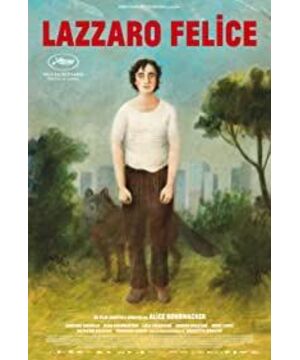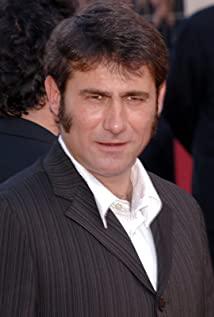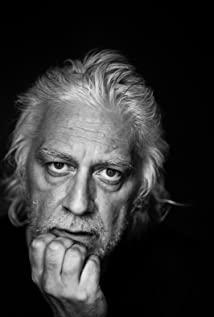This article was first published on [MOVIE Wooden Guardian] (WeChat account: movie345)
The beginning of "Happy Lazzaro" is like a naturalistic 19th-century Italian country style painting, like a group of peasant figures lifted from the soil, a marriage proposal inspired by a bagpipe folk song, tall and lush and covered by layers of tobacco leaves. The fields, the rough and simple farmhouses, the animals running about, seem to be directly derived from the idyllic image of Hermano Olmi, "The Clog Tree".
However, such a plain and simple picture of life soon appeared a crack in the splicing of history. A discussion about going to the city that accompanies the marriage proposal begins to unravel what makes the village special: modern necessities, car trucks and first-generation cellphone ringtones appear out of place alongside pre-modern clothing and farming practices; engagement A pair of lovers who want to leave the countryside afterward are not blessed to go to Milan like the newlyweds in "The Clog Tree", but are hindered in every possible way by priests and family members; the debts of the farmers and their master, the Marchioness The village left more of a mystery - feudalism should have been abolished at the very beginning of the republic.
The appearance of the Marquise with her son Tancredi on vacation brings out the absurd truth of this strange village - in fact, the Countess has long deceived the isolated villagers, never telling them that the tenant system has long been abolished, leaving them with no income. Provide raw materials for her tobacco factory under the circumstances, and use the ever-increasing debt to firmly imprison them on this land to work for her.
"Let them drown in misery. Now they suffer, but don't know the truth. I exploit them, and they exploit the weaker," she explained her philosophy of feudalism.
Tancredi, who hates his mother, fakes his own kidnapping case in a clumsy way, trying to defraud his mother of money and return to the city. Out of curiosity or a game mentality, he fell in love with Lazaro as a playmate. The young man who was called by the Marquise at the bottom of the "exploitative food chain" was called around by everyone because of his pure kindness, and sincerely believed in the brotherhood between him and Tancredi.
Blessed Saint Lazzaro
If it weren't for Lazzaro's character, then the film tells just an incredible anecdote about how the marquise enslaves deceit and commits heinous crimes, and how the ignorant tenants are liberated and transformed by modern society.
Lazaro is happy because his heart is pure and ignorant of the world. Although he has no status, wealth, or intelligence that can break the world, because of this, his intelligence seems to never understand and never realize others. The teasing and bullying, and the feudal lord's taxation and exploitation on the shoulders of all the villagers, can't understand the frustration of the young people who want to leave this place. He is like the legends praised by Christianity. Like a saint, he stands firm in his beliefs and commitments, never wavering.
Different from the protagonist in director Aliche Rohrwacher's first two works "The Eucharist" and "Miracle", who is a girl with autobiographical life experience, Lazaro is more like an "inhuman" protagonist , a mysterious knot that entangles past life and contemporary reality. The female perspective that favors growth in "The Eucharist" is no longer limited to the delicate spiritual writing in "Miracle". When following the girl's exploration trail, a dream-like fantasy appears. In "Happy Lazzaro", although the camera closes the innocent face of the boy with many close-ups, it never reveals the boy's inner activities other than joy and sorrow. In the narrative, he does not even provide any protagonist. Viewpoint, his performance and behavior do not affect and promote the development of the plot, and he does not undertake to reshape the bystander perspective of the incident. He allows the audience to withdraw from the mainstream narrative viewpoint and indulge in distant reverie and pursuit. In the endless exploration of the unknown, nothing was found in the end.
After falling off a cliff in search of Tancredi, Lazaro is miraculously reborn, like a biblical saint from the dead. This isn't the first time the director has presented the mysterious phenomenon of alternate visions of life and death. At the end of "Holy Body", Marta swimming across a pond holds a tail that is still actively beating, which may come from a kitten who was brutally thrown to death. In "Miracle", a beekeeper girl swims to an isolated island full of cemeteries, trying to find Martin, a boy whose life and death are unknown and whose traces are unknown. Here, water becomes a medium between the visible and tactile objective world and the invisible and intangible natural world that can only be felt by perception. Lazzaro, who was standing outside the house, was drenched in a drenched thunderstorm, just like the dark pond under the bridge and the blue water surrounding the isolated island. Silently leaned over to melt into Lazaro.
As Antonia tells the story of the saint and the wolf to her young son in a voice-over, the wolf leans over and sniffs the body of Lazaro, who fell off a cliff. "The smell of a good man stops the wolf's desire to eat the saint," Antonia said. At the same time, Lazaro opened his eyes and returned to the world in the face of the baptism of the sacred sunlight.
Everything in the world he once dreamed of - the village Inviolata has become a corner abandoned and forgotten by the outside world, and the villagers who once lived and worked together have experienced changes in the vicissitudes of life for more than 20 years. In Lazaro, the physicality of time stands still. Consistent pure heart and unchanging appearance, wrapped in a mysterious and inexplicable aura of divinity.
The collapse of feudalism does not mean the end of exploitation
The gendarmerie, alerted by the kidnapping case, drove a helicopter to the sky over the village, and the roaring waves caused the villagers on the land to think they had seen the legendary monster. The camera looks down at the ancient village stagnated in pre-modern time and space, and the mysterious wall built by lies to block the development of history instantly vanishes.
The Marquise's exploitative and oppressive tenants were forced to evacuate their villages into the cities, and they faced what seemed to be a bright future: education, equality, wages, private ownership and civic power.
The medieval village life in the 1980s, isolated by lies and mountains, is connected by the mysterious return of Lazaro into the 21st century of modernization, urbanization and industrialization. In addition to the mysterious and grotesque atmosphere emanating from the images, there is also a rational criticism of the real society.
Rohr Wacher has always been concerned with the opposition between a natural economy that combines agriculture and cottage industry, and a commodity economy adapted to modern life, just like the family of the primitive honey-producing family in Miracle and the modernized economy they reject. Production standards and commercialized business models.
The first half of "Happy Lazzaro" is composed of primitive farming and planting methods and oral legends and stories, which are in contrast to the second half of modern life, which is rich in material, developed in science and technology, and permeated by rational experience. The change from tenant to citizen status has not changed the reality that the peasants from Inviolata live in the lower classes of society.
Rohr Wacher's lens often resides in the frustrated space abandoned in the corner of the times, staring like a ghost at the abandoned church where the icon of Jesus was taken away like a heart in "The Holy Eucharist", "Miracle". "The empty house left by the beekeeper's family who disappeared out of thin air, and the lost village in "Happy Lazaro", the camera's gaze softly touches the wall of memory, and goes to the place where the breath and voice oscillate. The home bedroom, and in the fantasy dwells lost memories.
After waking up, Lazaro left his hometown for a long journey to find his friend Tancredi, and all he could see was a harsher reality than that of a backward and closed feudal farm like Inviolata: refugees and unemployed queuing up for odd jobs with only a few euros, banks The family wealth was plundered through debt mortgages; the Antonia family lived in abandoned water tower boxes, leaving the land they depended on, and had to make a living through theft, robbery and fraud; Tancredi, the former marquis master, although still living in a decent In the big house, he lost everything because of bankruptcy, and he was drunk all day long in alcohol and dreamed to death, turning reality upside down. Even after leaving the feudal system that imprisoned them, they are still marginalized groups rejected by mainstream society. Under the impact of modern industrial civilization, they are powerless to fight back. spend the day. The villagers, liberated from darkness and ignorance, seem to have fallen into yet another intricate social exploitation.
Even the religions of Divine Mercy had no place for them, and the nuns drove the group of people who wanted to listen to music from the church. At this moment, a moment of divinity appeared again: the sound of the sacred organ at the time of Vespers seemed to have spirituality and consciousness, followed Lazaro and his party away, sneaked out of the church, crossed the porch, and followed the warm evening breeze, Wander around them. Sitting alone under the tree, Lazaro wept silently, and was determined to seek justice for Tancredi, his friend who lost everything.
At the end of the movie, Lazaro fell into a pool of blood with his eyes wide open, unknown to his life and death. At this time, the divine spirit that once leaned down, called him to wake up, and summoned music did not protect him from harm. The wolf who had been staring at him suddenly left and ran toward the camera through the traffic. The film doesn't dwell too much on sentimental sympathy and sentimentality, but ends the fable with a folklore-like telling. It dismantles all the definite and thorough value systems in modern society, and drowns the distinct modern life marked as a template in a faint and elusive mysterious halo.
Free from fantasy and reality, across the border between ancient and modern, what Ror Wacher presents is not only a legend, an illusory dream, but also a true portrayal of contemporary Italy, erasing the ancient illusion of the dusty village of Inviolata , is the mirror-clear evolution of contemporary European society: refugees and migrants struggling to survive, forced unemployed workers, displaced bankrupt, the film stands on the confusion of the past and the present, trapped in the unknown Between the mystery and the truth reduced to one, the focus is more on the realistic anxiety about the future.
View more about Happy as Lazzaro reviews










